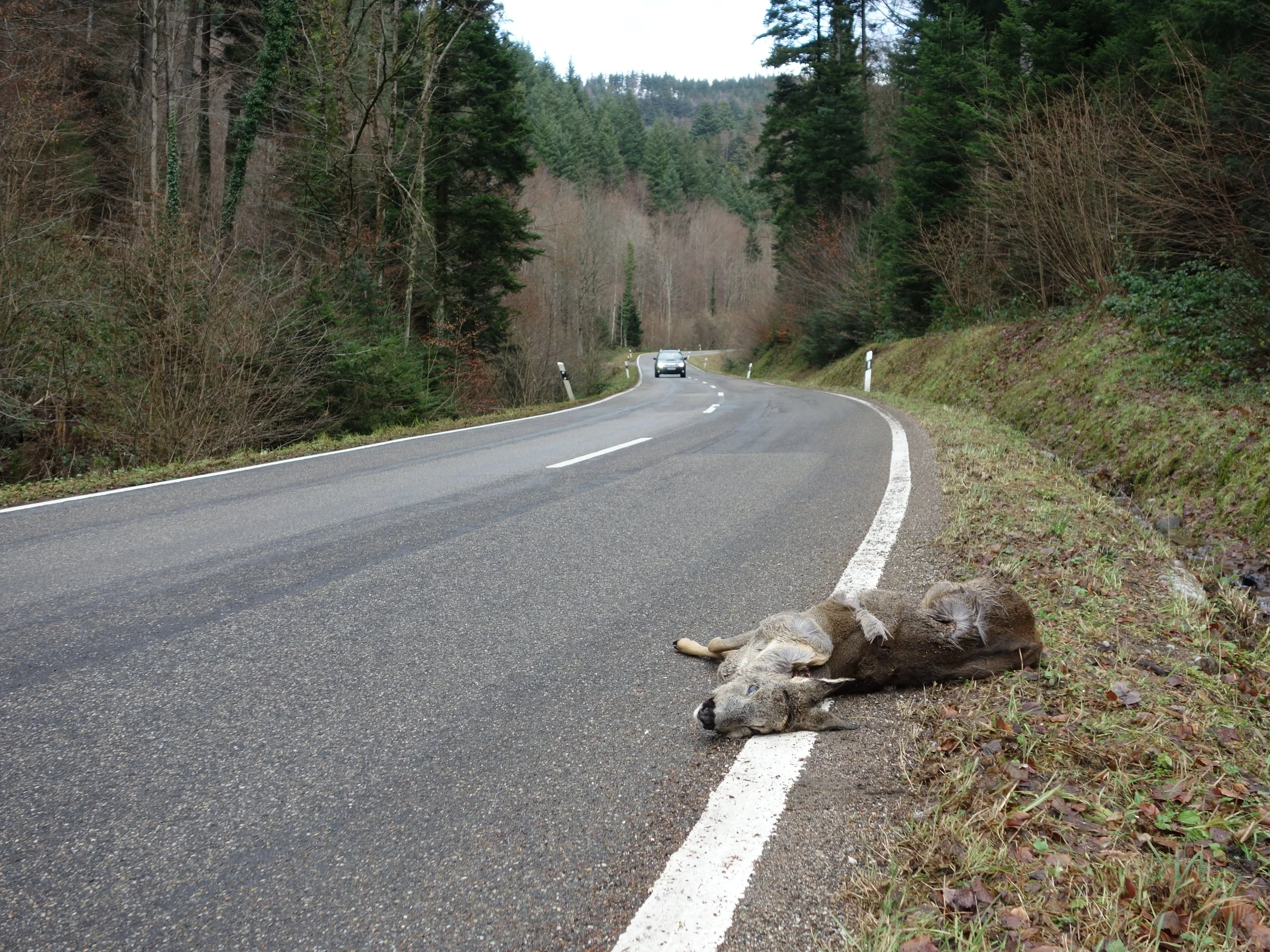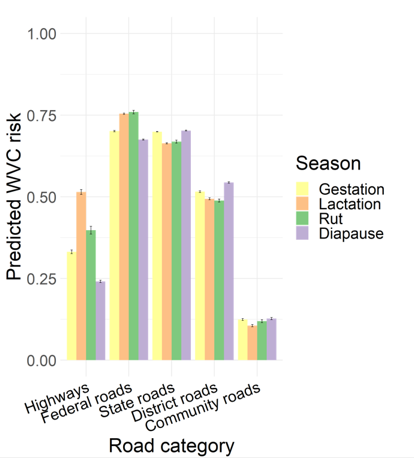Understanding where and when collisions with roe deer and vehicles occur can help to inform mitigation planning
Written by Johanna Heeres
Forest Research Institute Baden-Württemberg/Germany
July 7th 2025
Photo credit: Forstliche Versuchs- und Forschungsanstalt Baden-Württemberg
In Germany, roe deer account for the vast majority of registered wildlife-vehicle collisions (WVC), with on average one WVC occurring every two minutes. This results in the loss of more than 200 000 roe deer per year!
Accidents with roe deer can also be fatal for people, with around ten people dying and 2,000 to 3,000 injured each year, as well as one billion euro of property damage.
Figure 1: Predicted influence of the probability of wildlife-vehicle collisions (WVC) occurrence on the number of crossings per day in roe deer per sex and season. The 95% confidence interval is indicated in coloured shading.
Clusters of where WVCs occur are typically used to identify ‘WVC hotspots’. While hotspots are clear areas where wildlife and traffic collide, road sections with few WVC (sometimes called ‘coldspots’) could be the result of two possible scenarios:
1. Roe deer mostly cross these roads successfully and therefore no collisions occur.
2. Roe deer avoid these roads completely, and refrain from crossing in the first place.
In this study, we explored how WVC data compares with crossing behaviour, to identify patterns in where and when both, crossings and collisions, occur.
Risk of collision increases the more roe deer attempt to cross roads, especially for males during the rut
It was not surprising to find that the risk of WVC increases with increased rate of crossing (Figure 1). This was especially true for males during the rut, when they are actively searching for females for mating, and decreasing during other times of the year.
Collisions peaked in areas with lower-than-average road density
The average road density in Germany is 6 km of road per square km, and the highest risk of WVC occurred where road density is 2.2 km/km2 (Figure 2; left). These areas tend to be near villages and on the outskirts of cities. Denser areas of the road network are likely to occur close to cities and larger built landscapes, which support fewer roe deer. Areas with a high road density of 10 km/km2 or more also typically have high daily traffic volume, which is likely to increase the avoidance behaviour of roe deer.
Figure 2: Risk of collision with roe deer at different times of year with increasing road density (left) and increasing cover of broad-leafed deciduous forest (right) within a radius of 200 m of each registered wildlife-vehicle collisions (WVC).
The presence of deciduous broad-leaf forest increased rates of WVC
The risk of WVC with roe deer increased significantly from a base-rate of about 50% to more than 80% in areas dominated by broad-leafed deciduous forest (Figure 2, right). These forests provide cover and food for roe deer, which increases their abundance near the road. High tree density and bushes may also reduce the visibility of deer to motorists, limiting their ability to detect wildlife and avoid the collision (Figure 2; right).
Risk of collision was not highest on the busiest roads
Surprisingly, the risk of WVC was highest on medium-road categories with an average of 5,000 to 15,000 vehicles per day (Figure 3). Most successful road crossings by roe deer occurred on municipal and county roads with lower traffic volume. These roads pose a much lower risk of being hit by a vehicle compared to roads with moderate traffic density and speed. Subsequently, roe deer crossed roads with high traffic and high driving speed roads less frequently. This behaviour could result in the busier roads acting as a barrier to the movement of roe deer.
Conclusion
Figure 3: Predicted rate of WVC with roe deer on different types of roads in Germany.
WVC are the result of a complex mixture of spatial habitat and infrastructure properties, seasonal patterns, as well as human and animal behaviour. The combination of these factors determine the occurrence of roe deer, the probability of a road crossing and the risk level that a WVC is likely to happen.
Our study suggested that there is a linear relationship between the number of road crossings that roe deer make and the risk of WVC. Not surprisingly, the more times a deer crosses the road, the greater the chances that it will result in a WVC. However, contrary to our expectations, we did not find a clear or consistent barrier effect of roads based on traffic volume or traffic speed. Instead, we found high levels of variation in the crossing behaviour among individual roe deer, and identified roads that were barriers for some individuals while being crossed often by others.
We conclude that the risk of WVC can only be predicted to a limited extent based on the WVC data that is being collected and used for planning road mitigation measures right around the world. We recommend that behavioural research is also needed to better understand animal behaviour and quantify the effect of roads on wild animals. Importantly, this knowledge will also help to prevent WVC and not only support biodiversity but also reduce impacts to motorists.
Author information
Johanna Heeres (formerly J. Märtz), Researcher at the Forest Research Institute Baden-Württemberg and PhD student at Albert-Ludwigs University Freiburg/Germany
johanna@maertz.eu
Source citation
Märtz, J.; Brieger, F. & Bhardwaj, M. (2024). Crossings and collisions – Exploring how roe deer navigate the road network. Journal of Landscape Ecology 39(101). https://doi.org/10.1007/s10980-024-01897-x
Editor:
Rodney van der Ree
Cite this summary:
Heeres, J. (2025). Understanding where and when collisions with roe deer and vehicles occur can help to inform mitigation planning. Edited by van der Ree, R.. TransportEcology.info, Accessed at: https://transportecology.info/research/where-and-when-dvc-occur-inform-mitigation





